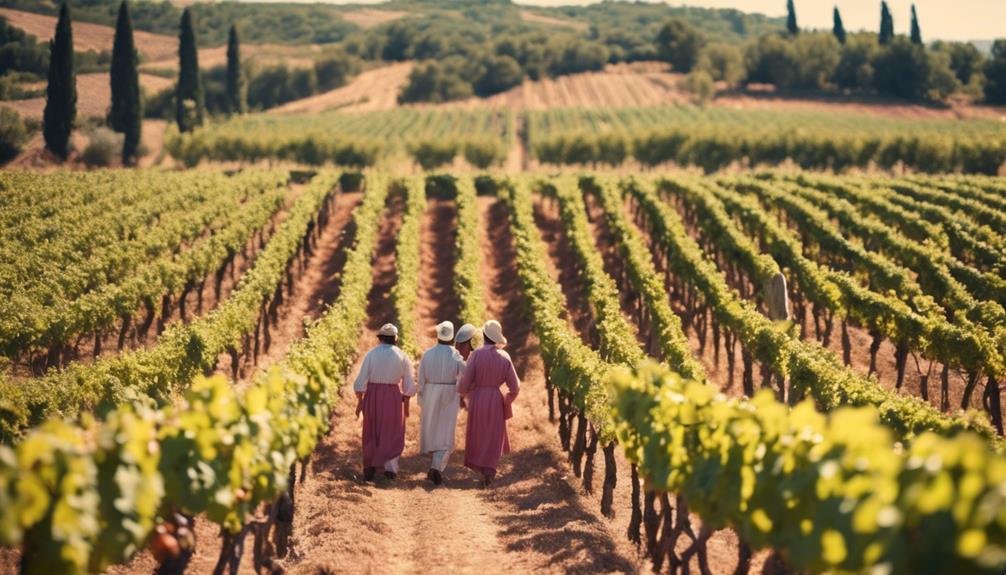The diverse world of rosé wines offers a spectrum of flavors, from crisp and fruity to lusciously sweet. Dry rosés complement salads and seafood, while sweet varieties are perfect as aperitifs or with desserts. High-quality rosés from regions like Provence can gain complexity with aging, appealing to different taste preferences. France and Spain lead in global rosé production, shaping the characteristics of these wines. Understanding regional disparities and popular blends can enhance your appreciation for the nuances of rosé. Each sip uncovers a new layer of taste experiences waiting to be explored further.
Rosé Wine Styles Overview
Rosé wine styles encompass a diverse range of flavors and characteristics, offering a vibrant spectrum of taste profiles for wine enthusiasts to explore.
When considering food pairings, dry Rosé wines are versatile and pair excellently with a wide range of dishes, including salads, seafood, and light meats. Conversely, sweet Rosé wines are best enjoyed as an aperitif or paired with desserts.
Regarding aging potential, most Rosé wines are meant to be enjoyed young and fresh to preserve their fruity and floral notes. However, some high-quality Rosé wines from regions like Provence in France can develop more complexity with a few years of aging, showcasing a different side of this delightful pink wine.
Global Rosé Wine Production
The worldwide production of pink wines has seen a significant increase in recent years, reflecting a growing consumer interest in the diverse and vibrant world of rosé wine.
Regional disparities play a vital role in shaping the characteristics of rosé wines. Countries like France and Spain lead the global production, each offering unique styles influenced by local traditions and grape varieties.
Popular blends in rosé wine production often involve a mix of 2-3 grape varieties, contributing to the complexity and balance of flavors.
Understanding these regional differences and popular blends can help wine enthusiasts appreciate the various profiles that rosé wines have to offer, making it an exciting exploration for wine lovers around the world.
French Influence on Rosé Wine

French winemaking traditions have greatly influenced the evolution and refinement of the global rosé wine industry. French Rosé wines are known for their delicate flavors, elegant aromas, and distinctive characteristics that set them apart from other rosés around the world. The epicenter of French Rosé production lies in the South of France, where regional grape varieties like Grenache, Carignan, and Syrah thrive in the Mediterranean climate, imparting unique qualities to the wines. South of France Rosés are typically drier and zippier, while those from the Loire Valley exhibit a more invigorating and crisp profile. When exploring French Rosés, look for wines with a high percentage of specific grape varieties to experience the true essence of French influence on rosé wine.
| French Rosé Characteristics | Description |
|---|---|
| Delicate Flavors | Subtle fruit and floral notes |
| Elegant Aromas | Aromatic and inviting scents |
| Distinctive Profile | Unique qualities and style |
Frequently Asked Questions
What Food Pairings Work Best With Rosé Wine?
When considering food pairings for Rosé wine, think of light, fresh summer dishes like salads, seafood, and grilled vegetables. For dessert, opt for fruity or citrusy options to complement the wine's delicate flavors.
Can Rosé Wines Age Like Red Wines?
Rosé wines can age, but generally, they lack the robust tannins of red wines. Aging potential varies by style; some improve with time for subtle flavor development. Store in a cool, dark cellar, shielded from light and temperature fluctuations.
Are There Any Health Benefits to Drinking Rosé Wine?
Rosé wine may offer health benefits due to antioxidants like resveratrol, potentially aiding heart health. Moderate consumption is key. However, consult a healthcare professional before attributing health benefits solely to Rosé wine as part of a balanced lifestyle.
How Does Rosé Wine Production Impact the Environment?
The environmental sustainability of rosé wine production is an important consideration, with factors like irrigation, packaging, and transportation impacting its carbon footprint. Sustainable practices, such as organic vineyard management, can mitigate these effects.
Are There Any Famous Rosé Wine Festivals or Events Around the World?
Global celebrations of rosé culture abound, with renowned festivals like La Nuit en Rosé in New York and the International Rosé Festival in Cannes. These events offer a vibrant platform for enthusiasts to explore diverse rosé varieties and embrace the pink wine craze.
Conclusion
To sum up, Rosé wine offers a diverse range of flavors and styles that make it a unique and versatile option for wine enthusiasts. Whether you prefer a crisp and dry Rosé from Provence or a fruity and sweet Rosé from California, there is something for everyone to enjoy.
For example, a couple celebrating their anniversary might choose a bottle of sparkling Rosé to toast to their love and create a memorable experience together.
Cheers to the delightful world of Rosé wine!
